Abstract
The implicit feedback information associated with actual behavior can symmetrically reflect consumer preference, which is valuable and deserves a deep investigation. Considering the inherent uncertainty and fuzziness of implicit data, the question of how to depict consumer preference in such data is always a critical and difficult issue. In this paper, a fuzzy profiling-nonnegative latent factor (FP-NLF) model is proposed to address this problem. First, a fuzzy profiling (FP) procedure is designed for characterization of consumer preference at various levels, where the fuzzy set is introduced to manage the uncertainty and fuzziness of implicit data. Two series of strategies are provided to determine the comprehensive preference for different scenarios and commercial intentions. Subsequently, a nonnegative latent factor (NLF) model is adopted to make predictions in the case of notably sparse data. Finally, a higher quality recommendation is ultimately produced for which only the products satisfying given preference level are recommended. In addition, a case study with real data is conducted for a detailed demonstration, and the results reveal the feasibility and superiority of our proposal through comparative analysis. Finally, the sensitivity analysis explores the influences of changing weights of strategy, which can provide guidance for developing purposeful strategies to better serve consumers.
1. Introduction
The consumer plays a pivotal role in commercial companies. Series of data produced by consumers, of various types and forms, are collected and stored in corporate servers and are treated as a valuable enterprise asset that can guide senior managers in developing firm strategies [1], price strategies [2], and product line designs [3], etc. In addition, such data, usually called consumer feedback information, are further analyzed to comprehensively study consumer behavior, supply proper products or services to consumers, and therefore to improve consumer satisfaction and loyalty [4,5].
In actual life, consumers encounter difficulty in finding which items they might prefer when large quantities of information are created every day. The complication of searching targets reduces consumers’ interest and damages their loyalty to one website or one product. In this case, the recommender system (RS), usually provided by commercial companies, can help consumers by analyzing their preferences according to historical feedback information and thus recommending potential items of interest to them. Consumer satisfaction depends on the recommendation accuracy of the products and consequently impacts the commercial company’s profit; thus, the RS performance plays a substantial role. To make high accuracy prediction of the RS, researchers and commercial companies have explored many recommendation models [6,7,8]. The key of these models is to properly characterize consumer preference and offer a reliable prediction. Specifically, the consumer feedback data and the preference modeling approach are two vital issues in determining the characterization process as the first key step, and the prediction algorithm subsequently decides on the performance of the follow-up task.
In terms of characterizing consumer preference, current RSs are usually performed with explicit feedback data, most of which consist of multi-rating data of “1–5 stars” and text reviews [5]. However, collection of these types of data is complex because it requires service providers to design feedback pages in advance. In addition, the collected explicit data could be trusted only if consumers could clearly know their feelings and submit accurate feedback. However, this task places heavy pressure on consumers to understand themselves and furthermore to give an accurate score. Moreover, certain malicious behaviors such as deliberately assigning good or bad ratings make it difficult to distinguish trusted data. In considering these problems, researchers have shifted their attention to implicit feedback data [9,10], which can reflect consumers’ real behaviors and preferences, such as transaction data, browsing history, play counts of music, etc.
Nevertheless, a challenging procedure in utilizing implicit feedback data is to properly map actual behavior information to a computable preference rating in a symmetrical way. Studies have presented some solutions for this task. For example, Tong et al. [9] adopted the number of webpage visits as a reflection of preference in which high frequency indicates high preference. In the same way as using frequency data, Hu et al. [11] proposed a binary transformation solution dividing preference into like and dislike, represented as . However, binary preference was inappropriate for understanding consumer behavior and failed to consider natural noise existing in such data. In fact, consumer attitudes for products or actions are complex showing different levels of preference between dislike and like [12]. Moreover, inherent uncertainty and natural noise in the data are common and troublesome. For example, if a record shows that a consumer has clicked into a website, we cannot distinguish whether the action is done for preference or by accident or after which the consumer would dislike the website in the end. We will know the truth only if this type of behavior frequency increases [13]. Therefore, accurately characterizing consumer preference and managing uncertainty components are important for better use of implicit data. For capturing vague knowledge, Zadeh [14] proposed fuzzy sets which was widely applied to decision making problems. Similarly facing uncertain information, this fuzzy method is also suited for this study since it can represent consumer preference with membership function and handle the uncertainty involved. Therefore, this paper investigates a fuzzy method for characterizing consumer preference at different levels and handling natural noise, and thereby predicting unknown items of higher interest for the consumers with RS.
Finally, certain metrics are commonly selected to evaluate the performance of recommendation models, including the mean absolute error (MAE) [5], root mean squared error (RMSE) [5], precision [15] and recall [15], etc. When computing the precision and recall, the existing studies characterize the case as true if the predicted item appears in the real records, and otherwise, it is labeled as false. In contrast, in our study where customer preference is modeled at multiple levels, the “true case” that might lie at low level of preference would not be recommended. Therefore, by adopting a stricter and higher preference standard, this paper accomplishes a high quality recommendation.
Based on the aforementioned issues, we integrate the benefits of fuzzy tools for fuzzy profiling (FP) procedure and the nonnegative latent factor (NLF) method into a hybrid fuzzy profiling-nonnegative latent factor (FP-NLF) model for implicit feedback information to predict consumer preference. The main work and contributions of this paper can be summarized as follows:
- (1)
- Implicit data can aid us in tracking the real behaviors of consumers despite lacking of methods for modeling consumer preference [9,10]. Additionally, consumer preference is complex and existed at different levels, but current research usually characterizes it only in a rough manner and ignores natural noise. Considering these issues and taking the advantages of fuzzy sets for processing vague information, in this paper, we extract consumer preference from implicit feedback information and propose the method of FP to characterize actual behavior data in terms of preference ratings at different preference levels.
- (2)
- In case the recommendation results are directly generated without considering consumer preference for recommended items, the recommendation quality will be unsatisfactory [15,16]. Therefore, according to the understanding of consumer preference, two series of strategies are provided for preference integration and comprehensive utilization in different scenarios. A hybrid FP-NLF model is proposed that can systematically solve the problem mentioned above by providing high quality recommendation that satisfies various consumer preference levels.
- (3)
- To demonstrate our proposal, a case study is conducted using the sub-dataset of The Echo Nest Taste Profile Subset containing 100,000 records. To recommend items of higher preference, we revise the evaluation metrics to a higher requirement. The results show that high quality recommendation satisfying given recommendation level can be achieved compared with other four related models. Sensitivity analysis shows more details to develop strategies that can purposefully serve consumers.
The rest of this is structured as follows. First, the related literature of this research is provided in Section 2. Section 3 presents the proposed hybrid FP-NLF model for implicit feedback dataset. A case study is carried out in Section 4, in which describing detail and specific procedures of the proposal. Section 5 shows the results and makes discussions based on comparative analysis and sensitivity analysis. Finally, we give the conclusion and future work in Section 6.
2. Related Literature
2.1. Inferring Consumer Preference from Implicit Feedback
Many studies have inferred consumer preference from consumer feedback information (shown in Table 1) and have applied this type of information to various targets, such as recommending appropriate doctors [17,18], selecting personal hotels [19], and finding restaurants [5], etc. These previous studies were performed based on two types of consumer feedback information: explicit data and implicit data. Explicit data are mostly derived from online websites and are represented as multi-ratings and text reviews posted by consumers. For example, Li and Qian et al. mined explicit multi-ratings and text reviews from Amazon and accordingly built a consumer preference model to assist consumers in selection of a satisfactory cellphone [20], but low quality and untrusted data make this approach difficult to adopt. In contrast, despite the common belief that implicit feedback is valuable [13,21], there is a dearth of research that uses implicit data compared with explicit data. The difficulty lies in characterizing consumer preference from implicit ratings.

Table 1.
Related studies on inferring consumer preference from feedback information.
In general, it is difficult to obtain implicit data, which are not displayed on webpages. These types of data are produced and stored directly inside the company, usually in the form of clicks, transactions, and usage, which are regarded as behavior frequency. Current approaches to model consumer preference are transforming implicit feedback information into implicit ratings to represent preference. For example, the high frequency transaction of an item was interpreted and computed as a high preference of the consumer for the product [22]. Choi et al. [23] measured consumer preference according to the number of times music was played, where a high play count indicates a high preference. However, these studies characterized preference in the same scale and dimension. In fact, the frequency of behavior is closely related to the nature of the product [24]. Therefore, the preference characterized in different levels of frequency is properly in accordance with consumer emotion. Yera et al. [12] subtly described different levels of consumer preference using the fuzzy method. Considering its advantages of handling fuzziness in human behavior, the fuzzy method is similarly adopted in this study. With extending this approach, we map implicit feedback information to consumer preference at different levels, and at the same time, address natural noise with respect to fuzziness and uncertainty. This study could fill the research gap of characterizing consumer preference from implicit feedback information.
2.2. Latent Factor Model
RSs use different models to recommend unknown items. In general, collaborative filtering (CF) models and latent factor models (LFMs) are the most widespread techniques [26,27,28]. CF models recommend new items based on similarities between items [29] or users [30] according to ratings and are currently the most popular approaches adopted by commercial companies [31]. However, problems such as cold start and sparsity, among others, limit the performance of this approach. In contrast, the LFM [32] is becoming an appealing technique that predicts unknown entries using a matrix factorization approach. This method maps raw data to latent factor vectors for the sake of low dimensional computation and can reduce the levels of sparsity [33,34]. With respect to LFM for implicit data, specifically, Hu et al. [11] adjusted the original cost function after extracting consumer preference score for a better understanding of the specific scenario. Wu et al. [35] further improved the recommendation accuracy using novel kernel functions. Rendle et al. [36] developed a local weighted matrix factorization in an effort to handle the top-N problem. Although these methods can reach high accuracy, they neglect the nonnegative constraints of preference in the latent factor vector. After restricting the latent factor vector, Wang et al. [37] and Luo et al. [38] used the NLF model to decompose original information for hidden interpretation and further prediction of unknowns. The approach with the NLF model is better suited for implicit feedback information and thus provides one solution for the similar issue in this paper.
To better describe how the LFM works, an insight of the model is shown in Figure 1. As shown, when a record implies that the consumer likes one piece of music but dislikes another one, we can analyze this information by mapping it to the latent factor vector, such as the (lyrics, genre) vector. We subsequently obtain the consumer vector (0.9, 0.1) and item vectors (0.8, 0.8) and (0.1, 0.1), from which we can understand the preference score of the consumer and items for each latent factor. The dot product of the consumer vector and item vector presents the comprehensive preference of the consumer for the items. If we adopt the binary inference as in Refs. [11,23], and the preference ≥0.5, then the consumer is in favor of this item; otherwise, the consumer dislikes it. Finally, the model objective is to predict the unknown preference using observations.

Figure 1.
Illustration of the hidden feature of consumers and items.
After describing the core idea of LFM, the basic definitions are given as follows.
Definition 1.
[38] Given a matrix , where each element representing user ’s preference ratings on item and is the user ’s preferences rating of all items, the matrix is preference rating matrix.
Based on the preference rating matrix, the task of LFM is to predict the preference rating for unknowns with minimum differences.
Definition 2.
[38] Assume that and are preference rating matrices that indicate the observed data and the whole data in , respectively. The objective of LFM is to predict , whose element denotes entry , with minimum error .
The technique for solving the objective function factorizes preference rating-matrix into two latent factor matrices and in low rank, where is , is and . This procedure maps the original data to the same latent factor vectors to describe the features of the users and items hidden in the preference ratings. The factorization process is achieved via finding the latent factor vector by building two matrices and , which minimizes the difference between and , denoted by
Equation (1) is a basic objective of LFM. Subsequently, researchers have deepened related techniques [23,37,38], such as the solution method and parameter optimization, and subsequently extended it to many more application fields. In this paper, we add nonnegative constraints and regularization terms to Equation (1) to satisfy the scenario requirement for implicit feedback data.
3. Hybrid FP-NLF Model
This section proposes a hybrid FP-NLF model for processing implicit feedback information, so as to predict consumer preference and improve the quality of RS. A conceptual framework of our proposal is illustrated in Figure 2 and consists of five modules. The outline of each module is described as follows:
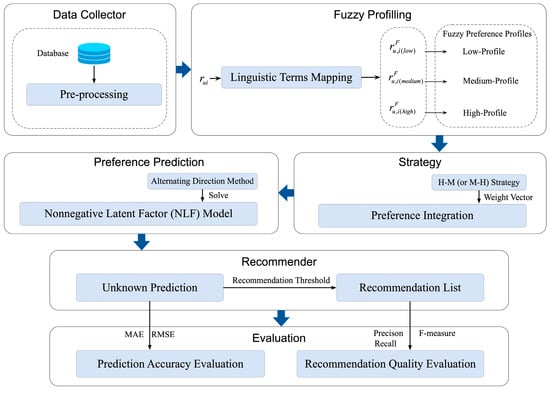
Figure 2.
Conceptual framework of the proposed hybrid fuzzy decision model.
- (1)
- Data collector: the implicit feedback information is collected and stored mostly in the company database, and it is preprocessed.
- (2)
- Fuzzy profiling: three preference levels are defined, and relevant membership functions [39,40,41] are built accordingly. The implicit feedback information on behavior frequency is transformed into preference ratings at each level, and thus the fuzzy preference profiles are obtained.
- (3)
- Strategy: to achieve a higher quality recommendation, the weights of the higher preference level are emphasized. By understanding consumer behavior patterns, two series of strategies are supplied for different intentions, which are used to generate the entire fuzzy preference profiles.
- (4)
- Preference prediction: according to the nonnegative requirement, we form NLF model by adding nonnegative constraints and regulation terms to the basic LFM [38] and use the alternating direction method [37] to solve the model.
- (5)
- Recommender: this stage is the last step of our model, which accomplishes the task of recommendation. The standard is enhanced in that the items are placed into recommendation list only if consumers have medium preference or high preference for them.
To avoid duplication, the processing details of data collector module will be explained in the next section with an illustration. The subsequent sections elaborate on the procedure for the rest of the modules in further detail.
3.1. Fuzzy Profiling
The main task of this section is to characterize the consumer preference rating via implicit feedback information based on the frequency. With the increase in frequency, the consumers are more likely to have a higher preference for the item [22]. However, the challenge of confirming the preference occurs with low frequency behavior, which contains substantial fuzziness and uncertainty. For example, if a record shows that a consumer has clicked into a website, we cannot distinguish whether this action is for preference or by accident or even the consumer subsequently dislikes the website eventually. For better managing uncertainty and fuzziness, the tool of fuzzy sets [14] is introduced. Since then, this tool has received much attention [42,43,44] and extended to various fields, such as decision making [45], fuzzy signatures quantization [46,47] and fuzzy control [48], etc. Considering its power for modeling vagueness, this approach is adopted and extended in this paper for characterizing consumer preference. The definition of fuzzy sets is reviewed as follows.
Definition 3.
[14] Fuzzy set is defined over the domain , and it can be denoted as a set of pairs of the element and its membership :
where the membership function maps the element of into the interval [0, 1], whose value represents the membership degree of belonging to .
In this paper, the classical fuzzy set is applied for FP of implicit feedback data, where we delicately characterize the consumer preference at different levels via the membership functions. The formulation of the problem is given to make a statement.
Denote the implicit feedback information as ( user with items) and means the usage frequency of user on item i. The linguistically represented label is arranged as l = l1 = low-preference, l2 = medium-preference, l3 = high-preference to describe the various preference levels for each consumer on the item. The fuzzy semantics is illustrated in Figure 3, where are determined in the exact application scenario. The next step is to construct the membership function that maps implicit feedback data to each linguistically represented label in . Therefore, we build the membership function to characterize the relationship between usage frequency and preference rating in each level by expanding the scale of 1–5 [12] to 1-N.
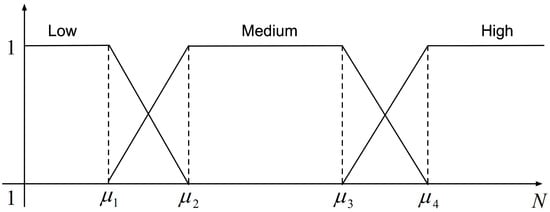
Figure 3.
Fuzzy definition of the frequency domain for the one to N times domain.
Through the process of linguistic representation, the preference ratings in each level are obtained and subsequently stored in three fuzzy preference profiles called Low Profile, Medium Profile, and High Profile, respectively. An illustration of the process is shown in Figure 4.
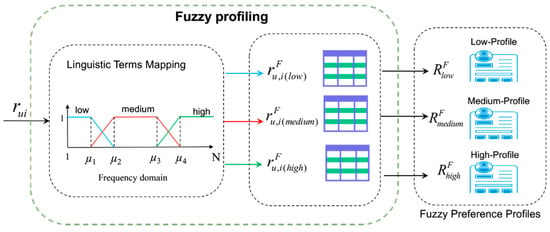
Figure 4.
Fuzzy profiling.
According to the linguistic terms defined in Figure 3, the obtained fuzzy ratings profiles are listed, and a brief description is given.
Low Profile : a file that contains the preference ratings in the low-preference level of the consumer on each item or behavior. It is better to carefully use it for recommendation because it embodies the fuzziness and uncertainty of information.
Medium Profile : a file that contains the preference ratings in the medium-preference level of the consumer on each item or behavior. Much attention is focused on this file based on the fact that consumer desire and psychological expectation are at least at the medium-preference level recommendation.
High Profile : a file that contains the preference ratings in the high-preference level of the consumer on each item or behavior. This file is valuable for keeping a record of the consumers favorites despite the small number of these types of data.
Specifically, the fuzzy preference profiles (including , , and ) are computed via the membership function , built as in Equations (3)–(5)
Remark 1.
For example, we assume an exact, and it is transformed byobtaining,, and. This indicates that consumerhas an 80% probability in the medium-level preference and a 20% probability in the high-level preference for itemwhen consumeruses the item10 times.
In this section, the fuzzy preference profiles are obtained. Based on these profiles, we can ultimately represent the comprehensive preference of the consumers according to a different design. An elaboration on the design is described in Section 3.2.
3.2. Strategy
After obtaining fuzzy preference profiles at different levels, we assign diverse weights for the three profiles and thereby generate various types of comprehensive preference profiles. Each designed weight vector is regarded as one strategy that reflects the recommendation manner and explains which level of preference of the products the RS wants to recommend to you. We represent the comprehensive preference rating of the consumers as and denote the weight vector as , where , , and represent the weight of Low Profile, Medium Profile and High Profile, respectively.
We form the strategies in this section based on observations of consumer behavior in accordance with common sense. For example, for consumers who want to be supplied items that they probably like or items for a surprise but not the ones that they frequently use, we can generate their ideal recommendations by setting the highest weight of Medium Profile. Similarly, for consumers who want to acquire items relevant to the ones that they always needed, we can accomplish this recommendation by setting the highest weight of High Profile. In addition, we directly abandon the optional strategies that consumers want to be recommended the items of interest at low-preference level. Thus, based on above observations, two types of recommendation strategies are constructed and listed in the following, which directly remove the choices with the higher weight of Low Profile according to common sense:
- Strategy 1, denoted as “H-M”:
This strategy assumes that consumers prefer to be recommended items of interest at high-preference level.
- Strategy 2, denoted as “M-H”:
This strategy assumes that consumers prefer to be recommended items of interest at medium-preference level.
The specific strategy is determined with the understanding of the consumers in the real scenario, which offers a chance for the company to adjust their commercial strategies for various goals. If the relationship between the consumer and service provider is in the low level of stickiness, the strategy for the goal of high-preference level recommendation should be used to enhance their satisfaction. If the consumer is already satisfied with the service, we can achieve a recommendation focused on the medium-preference level, which can provide some surprise items.
After the process of this module, the items of highest comprehensive fuzzy preference determined through the aggregation are more likely to be placed into the recommendation list.
3.3. Preference Prediction
With the above two modules, the customized comprehensive fuzzy ratings of consumers can be obtained, thus achieving the important issue of mapping the implicit feedback information to preferences. Once we obtain the preference ratings, the next stage is to predict the consumers’ unknown preferences on certain items, and the predicted preference ratings are denoted as . We construct a prediction method to achieve this task, and the principle of utilizing a model is in accordance with the specific scenario. In this paper, the latent factor vectors that represent the preference attributes should be nonnegative, and therefore the NLF model is adopted to produce the prediction preference profiles , whose element is the predicted preference of user on item .
After adding the nonnegative constraints, the objective of LFM in Equation (1) is revised to
and Ref. [38] supplies the solution. Specifically, when using the Euclidean distance and adding the regularization terms with the Frobenius norm of the latent factor vectors, the objective of the NLF model is reformulated as
where and are the parameters of the regularization terms and are constants, and represents the Frobenius norm of a matrix. With the aid of the alternating direction method [37], we can obtain the update rule and thereby obtain the solution for which the relevant computation is executed on the Python platform.
3.4. Recommender
This module is the final phase of our proposal to achieve the recommendation. We accomplish this task by predicting unknown preference ratings and further producing the final recommendation list. In the process of generating recommended items, the current recommendation approach determines final lists by ranking the predicted ratings and choosing the highest ones, no matter if they are at low-preference level. In contrast, due to the various levels of preference division, this paper can enhance the recommendation quality to reach higher satisfaction for consumers, and the current rule of recommendation is revised. The benchmark is improved by setting two thresholds of medium-preference level and high-preference level. With the threshold of medium-preference level, the item is not placed into the ranking list only if the predicted rating is over the setting value of medium-level, and the same with the threshold of high-preference level. Therefore, certain evaluation metrics are accordingly modified when the model runs, and are introduced in the next section.
3.5. Basic Evaluation Metric
To validate the proposed FP-NLF model, we introduce some common evaluation metrics. RMSE and MAE are chosen for measuring the model accuracy; precision, recall and the F-measure are adopted to assess the recommendation quality, which are modified to the higher requirement in our research.
RMSE and MAE both measure model performance by computing the deviations between the actual preference ratings (denoted as ) and the predicted preference ratings (denoted as ). The RMSE and MAE metrics are given as follows:
where is the number of samples of the model. Obviously, RMSE is by definition always bigger than MAE, but they are commonly used together for comparing model errors.
The precision, recall and F-measure are adopted to evaluate the recommendation quality of the model. In a previous study, the recommendable items were classified as relevant and irrelevant [5]. Differently, in this paper, we will further examine that whether the relevant items reach the given preference level or not. The relevant items that also pass the test of preference level are defined as qualified items, and can be eventually recommended. Given a top-N recommendation list for a consumer, the precision and recall are defined, respectively, in the formulas as below:
On this basis, the F-measure is given as the harmonic mean of the value of the precision and recall, denoted as below:
4. Experiment
This section describes the entire process of a case study that implements the FP-NLF model in detail. First, Section 4.1 covers collection of the data sets, and an analysis is described to supply guides for the following procedures. Section 4.2, Section 4.3, Section 4.4 and Section 4.5 describe the specific process of the FP module, strategy module, preference prediction module, and recommender module. The next section presents the results and relevant discussion.
4.1. Data Collector and Pre-Process
A case study is conducted using the proposed FP-NLF model on the data set of The Echo Nest Taste Profile Subset (http://millionsongdataset.com/), provided by The Echo Nest for encouraging research on algorithms and recommender systems. The dataset contains real triple records of “user-music-play counts” from undisclosed consumers, which offers convenience for analyzing consumer preference and further recommendation of items in line with their tastes.
The Million Song Dataset (MSD) contains 1,019,318 unique users, 384,546 unique songs and 48,373,586 “user-song-play count” triplets. We randomly selected 100,000 pieces of records as experimental data for the application of the proposal, including 89,820 unique users and 43,997 unique MSD songs, the sparsity of which is 99%.
A portion of the original data is shown in Table 2, and each user ID and music ID has been anonymized.

Table 2.
Portion of records on the dataset.
For good visualization of the data and to obtain an overview of the consumer listening habits for further analysis, the data are shown from various aspects in Figure 5 and Figure 6. The maximum frequency with which each consumer has listened to an exact song is shown in Figure 5, the range of which is between 1 and 745 with most less than 100.
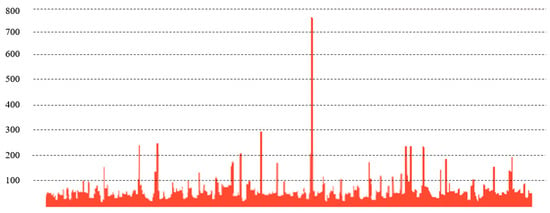
Figure 5.
Maximum number of times that each consumer has listened to an exact song.
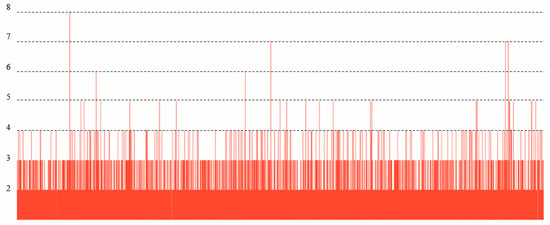
Figure 6.
Total number of songs to which each user has listened.
Figure 6 displays the number of songs to which each user has listened, where most users have only listened to 2 songs. This scenario shows the sparsity of the content quality, which is a common situation in RSs to be solved.
As a brief insight, this case study demonstrates the foundation of building membership functions and setting the recommendation threshold, as described in the following.
4.2. Fuzzy Profiling
Based on the overview of the dataset, namely, the real scenario, the relevant value in our model can be determined. The Frequency for a user’s listening behavior is distributed on the interval [1, 745] in the dataset. In practice, the fuzziest scenario in which a user has listened to a song only once, from which we cannot determine the user attitude. Conversely, if a song is played more than 15 times, we can empirically obtain the conclusion that the user likes it. According to the proof of distribution of the dataset, we specifically define the linguistic term representations indicating the various preference levels, which are mapped from the frequency range, and the membership function is depicted as follows:
The fuzzy profiles (including , , ) can be built according to the membership function , and the process can be executed in the next procedure.
4.3. Integration Strategy
Specifically, four types’ weights for each strategy introduced in Section 3.2 are deliberately arranged, and are listed as shown in Table 3.

Table 3.
Specific weights of fuzzy profiles.
With the various integration strategies, the comprehensive fuzzy ratings are derived and stored in .
4.4. Train Latent Factor Model
After obtaining the comprehensive fuzzy preference profiles , we construct the NLF model to accomplish the prediction task. We divide the dataset into 80% for the training set and 20% for the test set with 5-fold cross validation. Our model is established and trained on the Python platform, with which the solution can be derived. The regularization parameters and are arranged to be 0.1 as in previous research. A deep investigation of the algorithm parameters is not performed because it is not a point of emphasis in this research. The relevant comparison methods are constructed to verify the prediction accuracy in Section 5.
4.5. Recommender
In this step, the music with higher interest is recommended for the consumer. Specifically, only the music that satisfies the lower limit of a given preference level can be recommended, which means that the ones that fail the test of preference level will not be considered even if they are not at the low-preference level. Therefore, the thresholds for recognizing the higher preference level (denoted as ) including the medium-preference recommendation level () and high-preference recommendation level () are presented. The value of relies on the given recommendation level and weight vector of the Strategy. With the aid of the membership function , the specific value of can be computed to classify the items as qualified and unqualified when forming recommendation lists, and further used to evaluate the recommendation quality.
5. Results and Discussion
5.1. Results and Comparative Analysis
This section gives the experiment results with comparisons of other relevant methods. To scientifically measure the performance of the proposed model, four targeted approaches for comparison are built, including the user-based CF model (Model 1), the item-based CF model (Model 2), the k-nearest neighbors model (Model 3), and the proposed model removing the FP procedure (Model 4). The Models 1–3 are widely used as typical methods in RS, and all of them are added with FP procedure here for experimental control. Therefore, the prediction accuracy of the proposed model will be compared with the Models 1–3 in terms of MAE and RMSE. The Model 4 does not participate in the comparison of prediction accuracy due to its different scales while removing FP procedure, but the goal of this design is exactly to verify the efficiency of FP process. Therefore, the recommendation quality will be examined and compared between the proposed model of all strategies (denoted as strategy 1-X and strategy 2-X, where X = 1, 2, 3, 4) and the Models 1–4. The detailed results are shown and discussed below.
(1) The prediction accuracy of MAE and RMSE
The MAE and RMSE metrics are used for measuring the prediction accuracy in this study based on the fivefold cross-validation, and Table 4 and Figure 7 list the results. For intuitive illustration, from Figure 7, it can be observed that all the MAE and RMSE values obtained by the proposed model of the whole strategies are smaller than those obtained by the Models 1–3. This result implies the superiority of the NLF model compared with the traditional CF recommendation algorithms, especially for the notably sparse data as in our study.

Table 4.
Mean absolute error (MAE) and root mean squared error (RMSE) results.
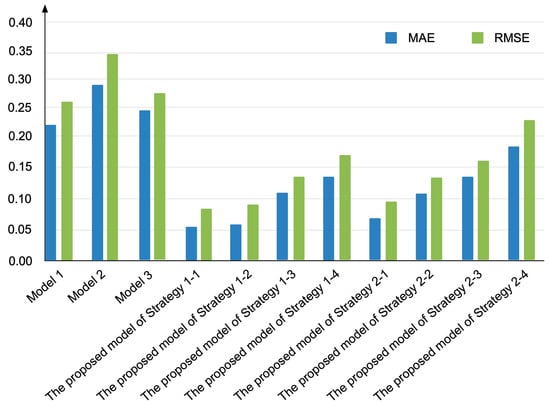
Figure 7.
MAE and RMSE results of various integration strategies.
Differently, there are minor differences for MAE and RMSE values among the strategies according to Table 4, which shows the robustness of the proposed model to generate a stable training and results. Despite of the similar errors, the specific values of MAE and RMSE are increasing from Strategy 1-1 (and Strategy 2-1) to Strategy 1-4 (and Strategy 2-4). The reason causing this change is the increased weight difference between and among strategies, denotes as . To investigate its further influence for final recommendation, a sensitivity analysis is conducted in the next section.
(2) Recommendation quality
Used for measuring recommendation quality, the precision, recall and F-measure results with various are derived, shown in Figure 8 and Figure 9 and Table 5.
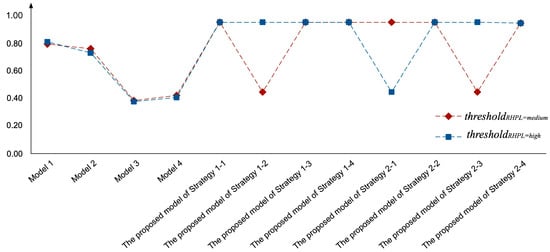
Figure 8.
Precision results of different .
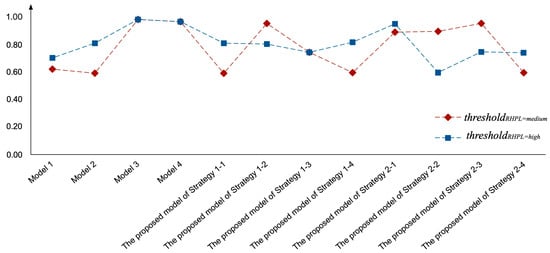
Figure 9.
Recall results of different thresholdRHPL.

Table 5.
F-measure of different .
Firstly, the recommendation quality of compared models will be discussed with precision and recall. Compared with our models from Figure 8, the Models 1–4 produce virtually the same worse precision results both in medium and high recommendation level. Additionally, the Figure 9 shows that the Models 1–4 reach higher recall results especially for high-preference recommendation level. To sum up, all of the compared Models 1–4 can derive good recall results but terrible precision results for different reasons. The bigger model errors of MAE and RMSE can explain the worse recommendation performance of the Models 1–3; while lack of the preference understanding for the recommended items can explain the Model 4’s insensitivity of various .
Secondly, the precision and recall results vary distinctly for our model based on different strategies. In general, almost all strategies can obtain the satisfied recommendation results with , but with where the items of medium-preference level are priority, it would be harder to make accurate prediction constantly. This result accords with our intuitive judgment of difficulty existing in the medium-preference level, and emphasizes the uniqueness of our model to accomplish surprised recommendation for medium-preference level items.
Thirdly, to make comprehensive evaluation, the F-measure results, derived through the balance between precision and recall value, are listed in Table 5. From Table 5, it can be generally observed that our model can obtain smaller F-measure than the compared Models 1–4, which indicates its better performance and superiority. However, the values of F-measure vary considerably among strategies. Especially at the medium-preference recommendation levels, there are large differences in the results. Therefore, although our model performs better overall, the best results depends on the implementation of specific strategies.
(3) Strategies selection
The setting of strategies provides flexibility of our model but also set up a task of selecting proper strategies. The better strategies should have excellent performance both in medium and high recommendation level. Despite the performance differences (shown as Figure 10) making the selection difficult, the multi-attribute decision making (MCDM) method [49] can help to provide a satisfying solution.
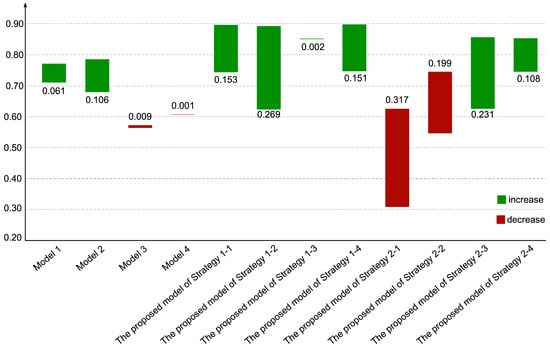
Figure 10.
Differences of F-measure from thresholdRHPL=medium to thresholdRHPL=high.
The Technique for Order Preference by Similarity to Ideal Solution (TOPSIS) [50], as a typical MCDM method, can provide a scientific ranking of results based on the distance to positive ideal solution and the negative ideal solution. Regarding the F-measure at different preference levels as evaluation attributes and adopting the average attribute weight, the ranking of these strategies can be obtained with the TOPSIS method. The ranking results are Strategy 1-3 Strategy 2-2 Strategy 1-4 Strategy 1-1 Strategy 2-4 Strategy 2-1 Strategy 1-2 Strategy 2-3. Figure 11 illustrates the selection results.
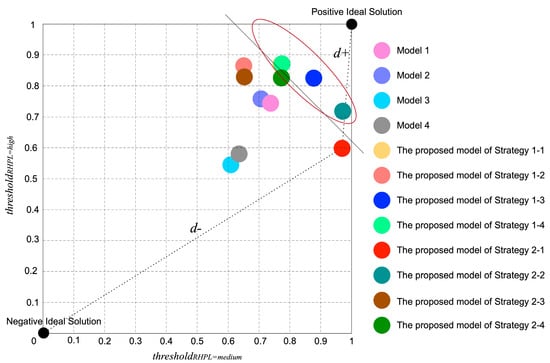
Figure 11.
Strategies selection based on F-measure.
5.2. Sensitivity Analysis
To further explore the influence of strategy weight, a sensitivity analysis is performed based on Strategy 1-2 and Strategy 2-2 since they both show distinct performance with various thresholds as Figure 10. First, the weight of is controlled for the convenience of comparison. Then we adjust , with step size of 0.05, in the range of 0.05–0.3 for Strategy 1 and in the range of 0.5–0.75 for Strategy 2, respectively. Accordingly, the weight of can be obtained. Finally, based on the proposed model, the F-measure at medium-preference level and high-preference level are derived, displayed in Table 6.

Table 6.
F-measure at different .
For Strategy 1 with , it can be observed that higher values are obtained at thresholdRHPL=high than thresholdRHPL=medium for all weight vectors. Denote the weight difference between and as , and we can discover that the better recommendation results could be generated with proper . In this experiment of , the optimal value of is 0.4 for Strategy 1.
For Strategy 2 with , the models with all the weights can derive excellent performance at thresholdRHPL=high. However, similarly, it cannot always get good results at thresholdRHPL=medium. When , the Strategy 2 can accomplish a brilliant recommendation result.
In conclusion, through sensitivity analysis of strategy weightings, we can see that the value of in fact influences the recommendation results, especially at thresholdRHPL=medium. In addition, a specific guidance for setting strategies with is derived that we can set for Strategy 1 and for Strategy 2 to obtain optimal recommendation.
6. Conclusions and Future Work
This paper focuses attention on implicit feedback information to analyze consumer preference and produce recommendations because these types of data record the actual behavior of consumers and can better reflect their preferences. However, it is difficult to directly use these data because the relationship between implicit feedback information and consumer preference is too complex to be extracted. Additionally, the inherent fuzziness in these data requires management. Therefore, a FP-NLF model is proposed to solve these problems and produce better recommendations. The proposal consists of five modules: data collector module, FP module, strategy module, preference prediction module, and recommender module. By taking advantage of the fuzzy sets and NLF, the goal of characterizing consumer preference in various levels and accordingly making a higher quality recommendation is achieved. Finally, a case study is conducted to demonstrate the procedure of our proposal in detail and validate its practice and efficiency under a higher requirement. The results show the feasibility and superiority of our proposed model, and sensitivity analysis provides more details for developing specific strategies.
This research presents a novel approach to acquire consumer preference from implicit feedback information and offer a higher quality recommendation. However, there are still some limitations of this paper. For example, the membership function that characterizes the preference relationship is constructed containing some subjectivity; and the strategy is better when personalized for consumers. In future, in addition to addressing the above limitations, more additional work remains for deepening the research. For example, we can consider more additional information such as other types of implicit data; real-time recommendation is still a research gap that deserves investigation, especially for implicit feedback. Moreover, as the situation becomes more complex, more uncertainty and fuzziness of various types appear, and many tools for managing the scenario remain to be explored. These extended problems will be investigated in our future work.
Author Contributions
Supervision, J.W. (Jianqiang Wang); Writing—Original draft, Y.L.; Writing—Review and editing, J.W. (Jing Wang). All authors have read and agreed to the published version of the manuscript.
Funding
This work is supported by the National Natural Science Foundation of China (No. 71901226), and Hunan Provincial Natural Science Foundation of China (Nos. 2019JJ51001 and 2018JJ3131).
Acknowledgments
The authors thank the editors and anonymous reviewers for their insightful comments and suggestions.
Conflicts of Interest
The authors declare no conflict of interest.
References
- Gu, J.Z.; Tayi, G.K. Investigating firm strategies on offering consumer customizable product. Inf. Syst. Res. 2015, 26, 456–468. [Google Scholar] [CrossRef]
- Jiang, Y.B.; Guo, H. Design of consumer review systems and product pricing. Inf. Syst. Res. 2015, 26, 714–730. [Google Scholar] [CrossRef]
- Xu, Z.B.; Dukes, A. Product line design under preference uncertainty using aggregate consumer data. Mark. Sci. 2019, 38, 669–689. [Google Scholar] [CrossRef]
- Tian, C.; Peng, J.J.; Zhang, W.Y.; Zhang, S.; Wang, J.Q. Tourism environmental impact assessment based on improved AHP and picture fuzzy PROMETHEE II methods. Technol. Econ. Dev. Econ. 2020, 26, 355–378. [Google Scholar] [CrossRef]
- Zhang, C.B.; Zhang, H.Y.; Wang, J.Q. Personalized restaurant recommendation method combining group correlations and customer preferences. Inf. Sci. 2018, 454, 128–143. [Google Scholar] [CrossRef]
- Cheng, H.-T.; Koc, L.; Harmsen, J.; Shaked, T.; Chandra, T.; Aradhye, H.; Anderson, G.; Corrado, G.; Chai, W.; Ispir, M.; et al. Wide & Deep Learning for Recommender Systems. In Proceedings of the 1st Workshop on Deep Learning for Recommender, Boston, MA, USA, 15 September 2016; pp. 7–10. [Google Scholar]
- Bao, J.; Zheng, Y.; Wilkie, D.; Mokbel, M.F. Recommendations in location-based social networks: A survey. Geoinformatica 2015, 19, 525–565. [Google Scholar] [CrossRef]
- Wang, M.X.; Wang, J.Q. New online recommendation approach based on unbalanced linguistic label with integrated cloud. Kybernetes 2018, 47, 1325–1347. [Google Scholar] [CrossRef]
- Lee, T.Q.; Park, Y.; Park, Y.-T. A similarity measure for collaborative filtering with implicit feedback. In Proceedings of the 3rd International Conference on Intelligent Computing: Advanced Intelligent Computing Theories and Applications. With Aspects of Artificial Intelligence, Qingdao, China, 21–24 August 2007; Springer: Heidelberg/Berlin, Germany, 2007; pp. 385–397. [Google Scholar]
- Zhao, J.L.; Fu, Z.B.; Sun, Q.X.; Fang, S.; Wu, W.M.; Zhang, Y.; Wang, W. MFMAP: Learning to Maximize MAP with Matrix Factorization for Implicit Feedback in Recommender System. KSII Trans. Internet Inf. Syst. 2019, 13, 2381–2399. [Google Scholar]
- Hu, Y.; Koren, Y.; Volinsky, C. Collaborative filtering for implicit feedback datasets. In Proceedings of the IEEE International Conference on Data Mining (ICDM 2008), Pisa, Italy, 15–19 December 2008; pp. 263–272. [Google Scholar]
- Yera, R.; Castro, J.; Martínez, L. A fuzzy model for managing natural noise in recommender systems. Appl. Soft Comput. 2016, 40, 187–198. [Google Scholar] [CrossRef]
- Chae, D.K.; Kim, S.W.; Lee, J.T. Autoencoder-based personalized ranking framework unifying explicit and implicit feedback for accurate top-N recommendation. Knowl. Based Syst. 2019, 176, 110–121. [Google Scholar] [CrossRef]
- Zadeh, L.A. Fuzzy sets. Information Control 1965, 8, 338–353. [Google Scholar] [CrossRef]
- Song, C.; Wang, X.K.; Cheng, P.F.; Wang, J.Q.; Li, L. SACPC: A framework based on probabilistic linguistic terms for short text sentiment analysis. Knowl. Based Syst. 2020, 194, 105572. [Google Scholar] [CrossRef]
- Tian, C.; Peng, J.J. An integrated picture fuzzy ANP-TODIM multi-criteria decision-making approach for tourism attraction recommendation. Technol. Econ. Dev. Econ. 2020, 26, 331–354. [Google Scholar] [CrossRef]
- Hu, J.H.; Zhang, X.H.; Yang, Y.; Liu, Y.M.; Chen, X.H. New doctors ranking system based on VIKOR method. Int. Trans. Oper. Res. 2018, 27, 1236–1261. [Google Scholar] [CrossRef]
- Yang, Y.; Hu, J.H.; Liu, Y.M.; Chen, X.H. Doctor recommendation based on an intuitionistic normal cloud model considering patient preferences. Cogn. Comput. 2020, 12, 460–478. [Google Scholar] [CrossRef]
- Wang, L.; Wang, X.K.; Peng, J.J.; Wang, J.Q. The differences in hotel selection among various types of travellers: A comparative analysis with a useful bounded rationality behavioural decision support model. Tour. Manag. 2020, 76, 103961. [Google Scholar] [CrossRef]
- Li, J.H.; Qian, Z.N.; Zhang, P.; He, Y.S. Hybrid recommendation algorithm based on multi-attribute rating from online reviews. In Proceedings of the ACM Turing Celebration Conference-China (ACM TURC 2019), Chengdu, China, 17–19 May 2019; pp. 1–7. [Google Scholar]
- Oard, D.W.; Kim, J. Implicit feedback for recommender systems. In Proceedings of the AAAI Workshop on Recommender Systems, Madison, WI, USA, 26–27 July 1998; pp. 81–83. [Google Scholar]
- Choi, K.; Yoo, D.; Kim, G.; Suh, Y. A hybrid online-product recommendation system: Combining implicit rating-based collaborative filtering and sequential pattern analysis. Electron. Commer. Res. Appl. 2012, 11, 309–317. [Google Scholar] [CrossRef]
- Lin, C.Y.; Wang, L.C.; Tsai, K.H. Hybrid Real-Time Matrix Factorization for Implicit Feedback Recommendation Systems. IEEE Access 2018, 6, 21369–21380. [Google Scholar] [CrossRef]
- Hamilton, R.W.; Ratner, R.K.; Thompson, D.V. Outpacing others: When consumers value products based on relative usage frequency. J. Consum. Res. 2011, 37, 1079–1094. [Google Scholar] [CrossRef]
- Lee, S.K.; Cho, Y.H.; Kim, S.H. Collaborative filtering with ordinal scale-based implicit ratings for mobile music recommendations. Inf. Sci. 2010, 180, 2142–2155. [Google Scholar] [CrossRef]
- Koren, Y. Factorization meets the neighborhood: A multifaceted collaborative filtering model. In Proceedings of the 14th ACM SIGKDD International Conference on Knowledge Discovery and Data Mining (KDD 2008), New York, NY, USA, 24–27 August 2008; pp. 426–434. [Google Scholar]
- Koren, Y.; Bell, R.; Volinsky, C. Matrix factorization techniques for recommender systems. IEEE Computer 2009, 42, 30–37. [Google Scholar] [CrossRef]
- Sundari, P.S.; Subaji, M. Integrating sentiment analysis on hybrid collaborative filtering method in a big data environment. Int. J. Inform. Tech. Decis. 2020, 19, 385–412. [Google Scholar] [CrossRef]
- Sarwar, B.M.; Karypis, G.; Konstan, J.A.; Riedl, J. Item-based collaborative filtering recommendation algorithms. In Proceedings of the 10th International Conference on World Wide Web (WWW 2001), Hong Kong, China, 1–5 May 2001; pp. 285–295. [Google Scholar]
- Zhao, Z.D.; Shang, M.S. User-based collaborative-filtering recommendation algorithms on hadoop. In Proceedings of the 3rd international conference on knowledge discovering and data mining (WKDD 2010), Phuket, Thailand, 9–10 January 2010; pp. 478–481. [Google Scholar]
- Gomez-Uribe, C.A.; Hunt, N. The Netflix recommender system: Algorithms, business value, and innovation. ACM Trans. Manag. Inf. Syst. 2015, 6, 1–19. [Google Scholar] [CrossRef]
- Jenatton, R.; Roux, N.L.; Bordes, A.; Obozinski, G.R. A latent factor model for highly multi-relational data. In Proceedings of the Advances in Neural Information Processing Systems (NIPS 2012), Lake Tahoe, NV, USA, 3–8 December 2012; pp. 3167–3175. [Google Scholar]
- Zeng, G.X.; Zhu, H.S.; Liu, Q.; Luo, P.; Chen, E.H.; Zhang, T. Matrix factorization with scale-invariant parameters. In Proceedings of the International Joint Conference on Artificial Intelligence (IJCAI 2015), Buenos Aires, Argentina, 25–31 July 2015; pp. 4017–4024. [Google Scholar]
- Wu, L.; Ge, Y.; Liu, Q.; Chen, E.H.; Hong, R.C.; Du, J.P.; Wang, M. Modeling the evolution of users’ preferences and social links in social networking services. IEEE Trans. Knowl. Data Eng. 2017, 29, 1240–1253. [Google Scholar] [CrossRef]
- Rendle, S.; Schmidt-Thieme, L. Online-updating regularized kernel matrix factorization models for large-scale recommender systems. In Proceedings of the 2008 ACM Conference on Recommender Systems, Lausanne, Switzerland, 23–25 October 2008; pp. 251–258. [Google Scholar]
- Wang, K.Q.; Peng, H.W.; Jin, Y.Y.; Sha, C.F.; Wang, X.L. Local weighted matrix factorization for top-n recommendation with implicit feedback. Data Sci. Eng. 2016, 1, 252–264. [Google Scholar] [CrossRef][Green Version]
- Luo, X.; Zhou, M.C.; Li, S.; You, Z.H.; Xia, Y.N.; Zhu, Q.S. A nonnegative latent factor model for large-scale sparse matrices in recommender systems via alternating direction method. IEEE Trans. Neural Netw. Learn. Syst. 2016, 27, 579–592. [Google Scholar] [CrossRef]
- Luo, X.; Zhou, M.C.; Xia, Y.N.; Zhu, Q.S. An efficient non-negative matrix-factorization-based approach to collaborative filtering for recommender systems. IEEE Trans. Industr. Inform. 2014, 10, 1273–1284. [Google Scholar]
- Peng, J.J.; Tian, C.; Zhang, W.Y.; Zhang, S.; Wang, J.Q. An integrated multi-criteria decision-making framework for sustainable supplier selection under picture fuzzy environment. Technol. Econ. Dev. Econ. 2020, 26, 573–598. [Google Scholar] [CrossRef]
- Wang, J.; Wang, J.Q.; Tian, Z.P.; Zhao, D.Y. A multi-hesitant fuzzy linguistic multi-criteria decision-making approach for logistics outsourcing with incomplete weight information. Int. Trans. Oper. Res. 2018, 25, 831–856. [Google Scholar] [CrossRef]
- Zhang, X.Y.; Chen, X.H.; Lin, X.D.; Wang, J.; Wang, J.Q. Towards a hybrid evaluation approach to Chinese sustainable drinking water source regions within an uncertain decision environment. Symmetry 2020, 12, 1303. [Google Scholar] [CrossRef]
- Yu, S.M.; Wang, J.; Wang, J.Q. An extended TODIM approach with intuitionistic linguistic numbers. Int. Trans. Oper. Res. 2018, 25, 781–805. [Google Scholar] [CrossRef]
- Hu, J.H.; Yang, Y.; Zhang, X.L.; Chen, X.H. Similarity and entropy measures for hesitant fuzzy sets. Int. Trans. Oper. Res. 2018, 25, 857–886. [Google Scholar] [CrossRef]
- İnce, M.; Yiğit, T.; Işik, A.H. A novel hybrid fuzzy AHP-GA method for test sheet question selection. Int. J. Inform. Tech. Decis. 2020, 19, 629–647. [Google Scholar] [CrossRef]
- Peng, H.G.; Wang, J.Q. Multi-criteria sorting decision making based on dominance and opposition relations with probabilistic linguistic information. Fuzzy Optim. Decis. Mak. 2020. [Google Scholar] [CrossRef]
- Nowaková, J.; Prílepok, M.; Snášel, V. Medical image retrieval using vector quantization and fuzzy s-tree. J. Med. Syst. 2017, 41, 1–16. [Google Scholar] [CrossRef]
- Yuhana, U.L.; Fanani, N.Z.; Yuniarno, E.M.; Rochimah, S.; Koczy, L.T.; Purnomo, M.H. Combing fuzzy signature and rough sets approach for predicting the minimum passing level of competency achievement. Int. J. Artif. Intell. 2020, 18, 237–249. [Google Scholar]
- Precup, R.-E.; Teban, T.-A.; Albu, A.; Borlea, A.-B.; Zamfirache, I.A.; Petriu, E.M. Evolving fuzzy models for prosthetic hand myoelectric-based control. IEEE Trans. Instrum. Meas. 2020, 69, 4625–4636. [Google Scholar] [CrossRef]
- Tian, Z.P.; Wang, J.; Wang, J.Q.; Chen, X.H. Multi-criteria decision-making approach based on gray linguistic weighted Bonferroni mean operator. Int. Trans. Oper. Res. 2018, 25, 1635–1658. [Google Scholar] [CrossRef]
- Wang, X.K.; Wang, J.Q.; Zhang, H.Y. Distance-based multicriteria group decision-making approach with probabilistic linguistic term sets. Expert Syst. 2019, 36, e12352. [Google Scholar] [CrossRef]
© 2020 by the authors. Licensee MDPI, Basel, Switzerland. This article is an open access article distributed under the terms and conditions of the Creative Commons Attribution (CC BY) license (http://creativecommons.org/licenses/by/4.0/).